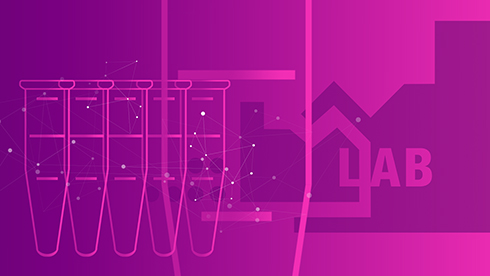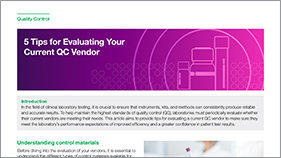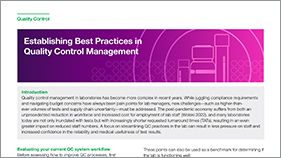Managing Laboratory Staff Burnout
Introduction
Burnout affects most laboratory professionals at some point, whether due to personal commitments, day-to-day family life, or stressors in the workplace. The Mayo Clinic defines job burnout as “a special type of work-related stress—a state of physical or emotional exhaustion that also involves a sense of reduced accomplishment and loss of personal identity.”1 In light of modern prioritization of productivity and working long hours, it is no wonder that laboratory employees are experiencing job burnout in record numbers: according to a survey done by the American Society for Clinical Pathology in 2020, 85% reported experiencing burnout in their career as a lab professional, and 50% stated it was a current problem.2 A 2023 article from Forbes summarized the challenges of modern burnout: “There is no rolling back the clock to the old days when employees subjected themselves to unrealistic demands of management to keep their jobs. No longer are managers willing to pay the price of burnout as a “normal” side effect of hard work.”3
Burnout is now seen as a threat to a stable workplace and something managers should be actively addressing. The typical modern workplace stressors have only been exacerbated by the COVID-19 pandemic, and have been especially long-lasting for the healthcare industry, including clinical laboratories. Learning how to manage burnout among lab staff not only facilitates keeping quality high, but also retaining personnel that are vital to lab work. Read on for an overview of the root causes and effects of burnout and ways to combat it in the lab.
Causes and effects of burnout
The 2020 publication “Gallup’s Perspective on Employee Burnout: Causes and Cures” identifies some of the root causes of burnout in the workplace: unfair treatment of employees, unmanageable workloads, unclear communication from managers, lack of manager support, and unreasonable time pressure.4 Apart from the larger systemic issues such as unfair treatment, many of these causes have been intensified by modern challenges for labs. Post-pandemic unreliability of supplies, staff shortages, economic hardships, and a large increase in the volume of tests have all created challenges—and stressors—for laboratory staff.
The effects of burnout in employees are often severe, from a decline in quality of work to quitting jobs entirely. According to U.S. Bureau of Labor Statistics data, approximately 4.9 million healthcare workers quit their jobs in 2019; that number increased to 6.1 million in 2021,5 illustrating that staffing shortages were a growing problem even before the pandemic. Because there are many potential causes and consequences of burnout, it is important to focus on the overall well-being of staff in addition to solving day-to-day problems they may encounter.
5 ways to help manage staff burnout
- Lessen unmanageable workloads by streamlining workflows. Evaluate current lab processes, practices, and procedures to see where it can better streamline workflows. Creating efficiency and increasing automation in the lab are long-term solutions for reducing the burden on staff by minimizing manual tasks, making the workload more manageable, and helping alleviate pressure from tight turnaround times. In the meantime, the following are short-term ways to help staff on a day-to-day basis.
- Encourage recharging during the day. Although managers may not be able to increase the amount of time given to staff for breaks, they can help foster wellness with recharging methods, such as meditation or taking a walk. Encourage staff to disconnect from their job during breaks and do not expect them to do any work-related tasks, such as paperwork. Having time to themselves is crucial to preventing burnout.
- Provide open communication and a forum for discussion. One of the best ways to help prevent or ease burnout is by ensuring the staff feels heard and respected. Holding a “town hall” style discussion can provide an opportunity for staff to voice their opinions, make suggestions, and have influence over their own work experience. Open and honest communication with personnel helps work feel like less of a burden and more of a team effort.
- Provide training, education, and support. Empower the staff by providing adequate training and education. If the staff does not already have comprehensive lab training in place, review and update SOPs and lab processes so staff have the proper resources to do their jobs correctly. Being trained on how to solve problems, developing new skills, and having the support of management can go a long way toward reducing the stress levels of staff members.
- Find ways to disrupt repetition. Are there scheduling changes managers can make to create more variety? Sometimes the monotony of doing the same tasks in the same order every day can result in boredom and frustration. Varying shifts and rotating assignments more frequently, if possible, can provide relief for laboratory staff.

Conclusion
There is rarely a simple solution for personnel burnout, and the work issues behind it can be exacerbated by outside or personal circumstances. However, to improve the well-being of staff and keep the focus on performing quality work, try some of the abovementioned tips for reducing or easing burnout. Making personnel feel heard, understanding their need to recharge, and enabling them to do their job by optimizing workflows and resources can increase job satisfaction and foster a sense of community in the lab.
References
1 https://www.mayoclinic.org/healthy-lifestyle/adult-health/in-depth/burnout/art-20046642
2 Wilson, L. Talking about burnout in the lab. (March 23, 2020) Retrieved from https://www.mlo-online.com/home/article/21260764/talking-about-burnout-in-the-lab, May 16, 2023.
3 New Outlook on Burnout for 2023: Limitations on What Managers Can Do. (February 2023) Retrieved from https://www.forbes.com/sites/bryanrobinson/2023/02/07/new-outlook-on-burnout-for-2023-limitations-on-what-managers-can-do/?sh=283038b44343, May 16, 2023.
4 Gallup’s Perspective on Employee Burnout: Causes and Cures. (2020) Retrieved from https://www.gallup.com/workplace/282659/employee-burnout-perspective-paper.aspx, May 16, 2023.
5 Job Openings and Quits Reach Record Highs in 2021. (2022) Retrieved from https://www.bls.gov/opub/mlr/2022/article/job-openings-and-quits-reach-record-highs-in-2021.htm, May 31, 2023.
Download the full article PDF




